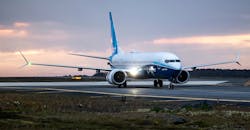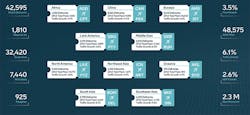Boeing Predicts Surge in Global Aircraft Demand
Boeing Co. issued a new 20-year forecast (2023-42) for the commercial aviation sector, anticipating continued growth in demand for new jets – with the total number of aircraft in service increasing by almost 100%. This development will result as individual markets’ domestic air travel continues to expand and international traffic returns to its pre-pandemic level. The latter detail will be apparent by 2024, according to Boeing, three years after most airlines and their suppliers were grounded by Covid-focused restrictions.
The jet builder issues an annual Commercial Market Outlook for the global aviation sector. In the current report Boeing projects the global industry will be comprised of 48,600 aircraft by 2042, nearly doubling its present size, Boeing noted, of which total 42,595 will be new aircraft – valued at $8 trillion. That amount will not include a separate $3.8 trillion for commercial services over the period of the forecast.
In terms of new aircraft demand, more than three-quarters (32,420) of the total to be delivered over the 20-year period will be single-aisle jets. Wide-body aircraft (7,440) and regional jets (1,810), plus new freighter jets (7,440) represent the rest of the new aircraft deliveries that Boeing forecasts.About half of all new deliveries over the 20-year period will involve various new, fuel-efficient models that will reduce aircraft emissions.
"The aviation industry has demonstrated resilience and adaptability after unprecedented disruption, with airlines responding to challenges, simplifying their fleets, improving efficiency and capitalizing on resurgent demand," stated Boeing senior vice president Brad McMullen. "Looking to the future of air travel, our 2023 CMO reflects further evolution of passenger traffic tied to global growth of the middle class, investments in sustainability, continued growth for low-cost carriers, and air cargo demand to serve evolving supply chains and express cargo delivery."
Among the regional trends Boeing identifies driving the growth of the sector are the continuing expansion of Asia-Pacific markets, toward 40% of global demand by 2042. Of that amount, half will be comprised of the Chinese commercial aviation sector.
The South Asian (mainly India) aircraft fleet will grow by 7% annually over the period of the forecast, the fastest of any regional market.
North America and Europe each will represent about 20% of global commercial aircraft demand.
Another continuing trend will be the growth of low-cost carriers, who will operate over 40% of the world’s single-aisle aircraft fleet in 2042. That would mean a 10% rise in demand by low-cost carriers since Boeing’s 2003 CMO.

